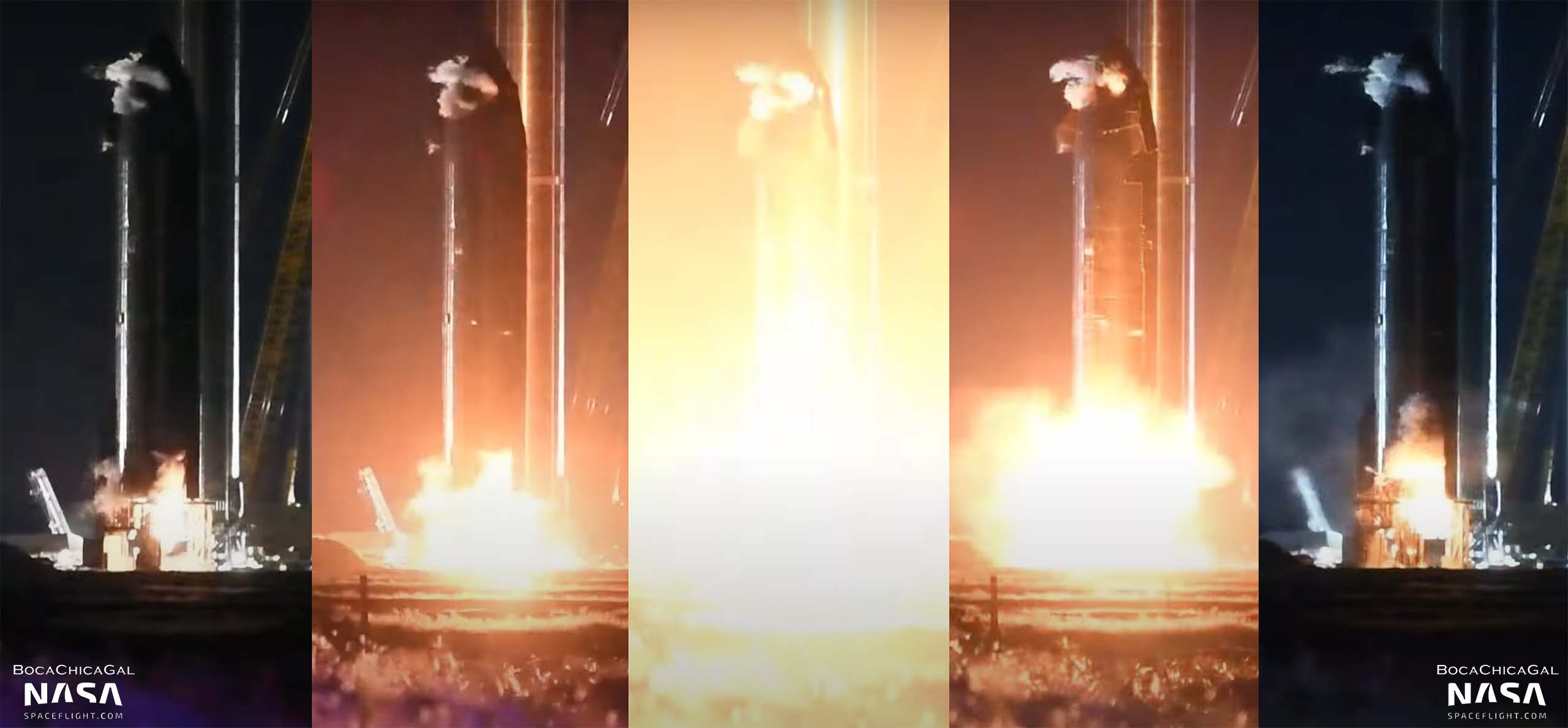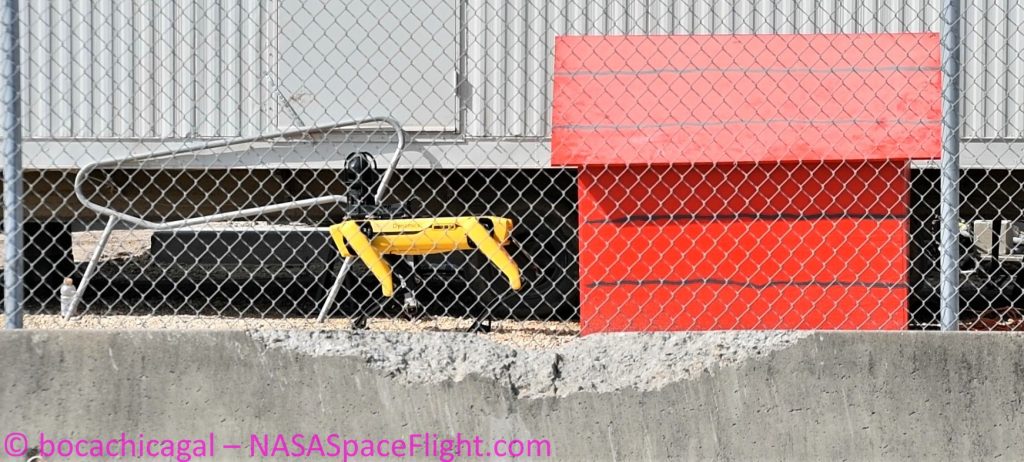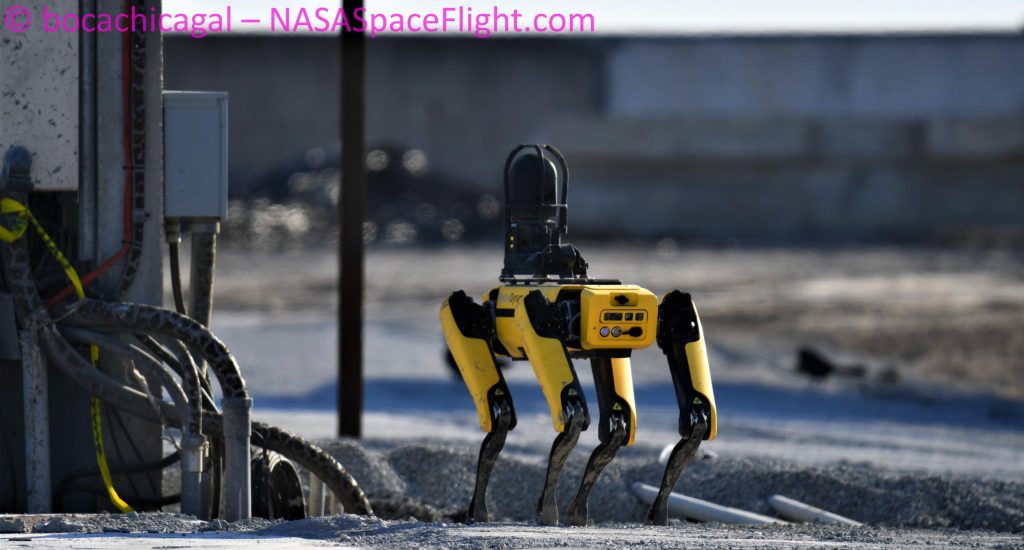

News
SpaceX uses robot dog to inspect Starship after first engine test in months
SpaceX’s first orbital-class Starship prototype has survived the first of several expected Raptor tests, kicking off an engine test campaign that could mark a number of new milestones.
With just 20 minutes left in a seven-hour test window, Starship prototype S20 (Ship 20) appeared to either unsuccessfully attempt its first Raptor static fire test or complete its first intentional Raptor preburner test around 11:40 pm CDT (UTC-5) on Monday, October 18th. Rather than a violent jolt and roar kicking up a cloud of dust, Ship 20 came to life with a (relatively) gentle fireball that lasted for several seconds.
In pursuit of maximum efficiency, Starship’s Raptors require two separate closed-cycle gas generators known as preburners to – as the name suggests – turn its cryogenic (very cold) liquid oxygen and methane propellant into a hot gas mixture that the engine re-ignites to produce thrust. A preburner test, if that’s what Starship S20 completed on Monday night, thus involves activating only the first half of that equation, rapidly producing a giant cloud of flammable gas without actually igniting to produce meaningful thrust.
Preburner tests have become increasingly rare as SpaceX’s sea-level Raptor design matured over the course of tens of thousands of seconds of ground testing and, later, thousands of seconds of ground and flight testing on Starship prototypes. Starship S20 had two engines during its first test. One Raptor was the sea-level optimized variant SpaceX has built dozens of and fired for 30,000+ seconds on the ground. The other, however, was a vacuum-optimized Raptor with a much larger nozzle – the first of its kind to participate in any kind of test while installed on a Starship prototype.
It’s possible that Raptor Vacuum (RVac) engines have even more design tweaks outside of their larger expansion nozzles. Regardless, SpaceX has only built and tested around 10 RVac prototypes over the last year, making it a less mature engine than its sea-level cousins. That could explain why SpaceX appears to have chosen to perform a preburner test first instead of jumping straight into a wet dress rehearsal and static fire. That also means that October 18th’s test was likely the first time a Raptor Vacuum engine has (partially) ignited while installed on a Starship.
The above view from a uniquely situated LabPadre camera all but guarantees that Starship S20’s first engine test was a Raptor Vacuum preburner test and doesn’t offer any strong evidence that it was a two-engine test. Ship 20 still has a number of crucial tests ahead of it before SpaceX can even begin to consider it (or its general design) qualified for flight. That includes multiple static fires, including the first side-by-side static fire of two Raptor variants (RVac and Raptor Center), the first simultaneous static fire of more than three engines, and the first Starship static fire with a full six engines installed.
Ship 20’s preburner test is SpaceX’s first Starbase Raptor test since the first Super Heavy booster static fire in mid-July, almost exactly three months ago.


With any luck, S20’s first preburner test has opened the door for an inaugural static fire of one or both installed engines later this week. However, during that preburner test, the giant fireball Raptor Vacuum emitted appeared to ignite several pieces of pad hardware. SpaceX took advantage of one of at least two Boston Dynamics Spot robots on-site to physically walk a camera up to the active pad and inspect several secondary fires. Ultimately, SpaceX appears to have successfully safed Starship with no damage to the vehicle itself, but odds are good that the sources of those secondary fires will need to be fixed and any pad damage repaired before Ship 20 proceeds into static fire testing. SpaceX has two more 5pm-12am test windows scheduled on October 19th and 20th.
Elon Musk
Why Tesla’s Q3 could be one of its biggest quarters in history
Tesla could stand to benefit from the removal of the $7,500 EV tax credit at the end of Q3.

Tesla has gotten off to a slow start in 2025, as the first half of the year has not been one to remember from a delivery perspective.
However, Q3 could end up being one of the best the company has had in history, with the United States potentially being a major contributor to what might reverse a slow start to the year.
Earlier today, the United States’ House of Representatives officially passed President Trump’s “Big Beautiful Bill,” after it made its way through the Senate earlier this week. The bill will head to President Trump, as he looks to sign it before his July 4 deadline.
The Bill will effectively bring closure to the $7,500 EV tax credit, which will end on September 30, 2025. This means, over the next three months in the United States, those who are looking to buy an EV will have their last chance to take advantage of the credit. EVs will then be, for most people, $7,500 more expensive, in essence.
The tax credit is available to any single filer who makes under $150,000 per year, $225,000 a year to a head of household, and $300,000 to couples filing jointly.
Ending the tax credit was expected with the Trump administration, as his policies have leaned significantly toward reliance on fossil fuels, ending what he calls an “EV mandate.” He has used this phrase several times in disagreements with Tesla CEO Elon Musk.
Nevertheless, those who have been on the fence about buying a Tesla, or any EV, for that matter, will have some decisions to make in the next three months. While all companies will stand to benefit from this time crunch, Tesla could be the true winner because of its sheer volume.
If things are done correctly, meaning if Tesla can also offer incentives like 0% APR, special pricing on leasing or financing, or other advantages (like free Red, White, and Blue for a short period of time in celebration of Independence Day), it could see some real volume in sales this quarter.
You can now buy a Tesla in Red, White, and Blue for free until July 14 https://t.co/iAwhaRFOH0
— TESLARATI (@Teslarati) July 3, 2025
Tesla is just a shade under 721,000 deliveries for the year, so it’s on pace for roughly 1.4 million for 2025. This would be a decrease from the 1.8 million cars it delivered in each of the last two years. Traditionally, the second half of the year has produced Tesla’s strongest quarters. Its top three quarters in terms of deliveries are Q4 2024 with 495,570 vehicles, Q4 2023 with 484,507 vehicles, and Q3 2024 with 462,890 vehicles.
Elon Musk
Tesla Full Self-Driving testing continues European expansion: here’s where
Tesla has launched Full Self-Driving testing in a fifth European country ahead of its launch.

Tesla Full Self-Driving is being tested in several countries across Europe as the company prepares to launch its driver assistance suite on the continent.
The company is still working through the regulatory hurdles with the European Union. They are plentiful and difficult to navigate, but Tesla is still making progress as its testing of FSD continues to expand.
Today, it officially began testing in a new country, as more regions open their doors to Tesla. Many owners and potential customers in Europe are awaiting its launch.
On Thursday, Tesla officially confirmed that Full Self-Driving testing is underway in Spain, as the company shared an extensive video of a trip through the streets of Madrid:
Como pez en el agua …
FSD Supervised testing in Madrid, Spain
Pending regulatory approval pic.twitter.com/txTgoWseuA
— Tesla Europe & Middle East (@teslaeurope) July 3, 2025
The launch of Full Self-Driving testing in Spain marks the fifth country in which Tesla has started assessing the suite’s performance in the European market.
Across the past several months, Tesla has been expanding the scope of countries where Full Self-Driving is being tested. It has already made it to Italy, France, the Netherlands, and Germany previously.
Tesla has already filed applications to have Full Self-Driving (Supervised) launched across the European Union, but CEO Elon Musk has indicated that this particular step has been the delay in the official launch of the suite thus far.
In mid-June, Musk revealed the frustrations Tesla has felt during its efforts to launch its Full Self-Driving (Supervised) suite in Europe, stating that the holdup can be attributed to authorities in various countries, as well as the EU as a whole:
Tesla Full Self-Driving’s European launch frustrations revealed by Elon Musk
“Waiting for Dutch authorities and then the EU to approve. Very frustrating and hurts the safety of people in Europe, as driving with advanced Autopilot on results in four times fewer injuries! Please ask your governing authorities to accelerate making Tesla safer in Europe.”
Waiting for Dutch authorities and then the EU to approve.
Very frustrating and hurts the safety of people in Europe, as driving with advanced Autopilot on results in four times fewer injuries!
Please ask your governing authorities to accelerate making Tesla safer in Europe. https://t.co/QIYCXhhaQp
— Elon Musk (@elonmusk) June 11, 2025
Tesla said last year that it planned to launch Full Self-Driving in Europe in 2025.
Elon Musk
xAI’s Memphis data center receives air permit despite community criticism
xAI welcomed the development in a post on its official xAI Memphis account on X.

Elon Musk’s artificial intelligence startup xAI has secured an air permit from Memphis health officials for its data center project, despite critics’ opposition and pending legal action. The Shelby County Health Department approved the permit this week, allowing xAI to operate 15 mobile gas turbines at its facility.
Air permit granted
The air permit comes after months of protests from Memphis residents and environmental justice advocates, who alleged that xAI violated the Clean Air Act by operating gas turbines without prior approval, as per a report from WIRED.
The Southern Environmental Law Center (SELC) and the NAACP has claimed that xAI installed dozens of gas turbines at its new data campus without acquiring the mandatory Prevention of Significant Deterioration (PSD) permit required for large-scale emission sources.
Local officials previously stated the turbines were considered “temporary” and thus not subject to stricter permitting. xAI applied for an air permit in January 2025, and in June, Memphis Mayor Paul Young acknowledged that the company was operating 21 turbines. SELC, however, has claimed that aerial footage shows the number may be as high as 35.
Critics are not giving up
Civil rights groups have stated that they intend to move forward with legal action. “xAI’s decision to install and operate dozens of polluting gas turbines without any permits or public oversight is a clear violation of the Clean Air Act,” said Patrick Anderson, senior attorney at SELC.
“Over the last year, these turbines have pumped out pollution that threatens the health of Memphis families. This notice paves the way for a lawsuit that can hold xAI accountable for its unlawful refusal to get permits for its gas turbines,” he added.
Sharon Wilson, a certified optical gas imaging thermographer, also described the emissions cloud in Memphis as notable. “I expected to see the typical power plant type of pollution that I see. What I saw was way worse than what I expected,” she said.
-

 Elon Musk3 days ago
Elon Musk3 days agoTesla investors will be shocked by Jim Cramer’s latest assessment
-

 News1 week ago
News1 week agoTesla Robotaxi’s biggest challenge seems to be this one thing
-

 News2 weeks ago
News2 weeks agoTexas lawmakers urge Tesla to delay Austin robotaxi launch to September
-

 Elon Musk2 weeks ago
Elon Musk2 weeks agoFirst Look at Tesla’s Robotaxi App: features, design, and more
-

 Elon Musk2 weeks ago
Elon Musk2 weeks agoxAI’s Grok 3 partners with Oracle Cloud for corporate AI innovation
-

 News2 weeks ago
News2 weeks agoWatch Tesla’s first driverless public Robotaxi rides in Texas
-

 News2 weeks ago
News2 weeks agoSpaceX and Elon Musk share insights on Starship Ship 36’s RUD
-

 News2 weeks ago
News2 weeks agoTesla has started rolling out initial round of Robotaxi invites

















